Research Article Open Access
Drought Assessment Based on Multi-Model Precipitation Projections for the Island of Crete
| A.-E. K. Vrochidou1, M. G. Grillakis1 and I. K. Tsanis1,2* | |
| 1Water Resources Management and Coastal Engineering Laboratory, Department of Environmental Engineering, Technical University of Crete, Greece | |
| 2Department of Civil Engineering, McMaster University, Hamilton, Ontario, Canada | |
| Corresponding Author : | Tsanis IK Water Resources Management and Coastal Engineering Laboratory Department of Environmental Engineering Technical University of Crete, Greece E-mail: tsanis@hydromech.gr |
| Received August 07, 2013; Accepted September 16, 2013; Published September 23, 2013 | |
| Citation: Vrochidou AEK, Grillakis MG, Tsanis IK (2013) Drought Assessment Based on Multi-Model Precipitation Projections for the Island of Crete. J Earth Sci Clim Change 4:158. doi:10.4172/2157-7617.1000158 | |
| Copyright: © 2013 Vrochidou AEK, et al. This is an open-access article distributed under the terms of the Creative Commons Attribution License, which permits unrestricted use, distribution, and reproduction in any medium, provided the original author and source are credited. | |
Visit for more related articles at Journal of Earth Science & Climatic Change
Abstract
Drought assessment and projection for the island of Crete was carried out with the aid of thirteen General Circulation Models (GCMs) output (precipitation), bias corrected, using the Representative Concentration Pathways (RCPs) 2.6, 4.5 and 8.5 scenarios of the Fifth Assessment Report (AR5) of the Intergovernmental Panel on Climate Change (IPCC). A comparison throughout three future time slices reveals a significant decreasing precipitation trend and temperature rise. The Spatially Normalized–Standardized Precipitation Index (SN-SPI) was calculated in order to evaluate the spatial and temporal distribution of droughts by classifying the stations in terms of severely and extremely dry conditions as a time percentage. Intensification of drought events is projected for the central and eastern part of the island during the last future period under study (2065-2099) under RCP8.5. The above findings should be taken into consideration for future strategy planning for drought management and warning systems development.
| Keywords |
| Drought; Precipitation; Models; Crete; Scenarios |
| Introduction |
| The potential impacts of climate change and global warming must be considered by water resource managers and the corresponding scientific communities, as water availability is increasingly being stressed [1]. Many studies have adopted various climate change scenarios to evaluate effects on meteorological parameters. The scenarios presented in the Special Report on Emission Scenarios (SRES) in the Intergovernmental Panel on Climate Change (IPCC) Fourth Assessment Report (AR4) [2] have been widely applied both for the investigation of hydrological responses to climate change and its projection globally and regionally [3-6]. The WCRP's (World Climate Research Programme) Working Group on Coupled Modeling (WGCM) has initiated a new set of coordinated climate model experiments that comprise the fifth phase of the Coupled Model Intercomparison Project (CMIP5). CMIP5 datasets will notably provide a multi-model context for assessing the mechanisms responsible for model differences in poorly understood feedbacks associated with the carbon cycle and with clouds, examining climate predictability and exploring the ability of models to predict climate on decadal time scales [7]. |
| General Circulation Models (GCMs), which describe the atmospheric process by mathematical equations, are the most adapted tools for studying the impact of climate change at regional scale. |
| The scenarios emerging from the new set of GCM experiments, are called Representative Concentration Pathways (RCPs) (Table 1) and constitute a set of greenhouse gas concentration and emissions pathways served to support research on the impacts climate change [8,9]. The Representative Concentration Pathway (RCP) 8.5 corresponds to a high greenhouse gas emissions pathway compared to the scenario literature [10,9,2], and hence also to the upper bound of the RCPs. The greenhouse gas emissions and concentrations in this scenario increase considerably over time, leading to a radioactive forcing of 8.5 W/m2 at the end of the century [11]. The rest pathways represent milder conditions and can be considered as moderate mitigation scenarios. |
| A large number of studies dealing with changes in precipitation and temperature are included in the international literature [12-14]. Kim [9] examined the combined impacts of future changes in climate and land cover on stream flow using the RCPs 4.5 and 8.5. Additionally, Vidal [15] used two emissions scenarios, six global climate models and four downscaling methods in order to build climate change scenarios for three catchment case studies in the UK. |
| Climate change is expected to affect precipitation, temperature and potential evapotranspiration, and, thus, is likely to affect the occurrence and severity of meteorological droughts. Drought is defined as a sustained and regionally extensive occurrence of below average natural water availability [16]. It is a phenomenon that can be characterized as a deviation from normal conditions in the physical system (climate and hydrology), which is reflected in variables such as precipitation, soil water, groundwater and stream flow. Drought is a recurring and worldwide phenomenon having spatial and temporal characteristics that vary significantly from one region to another [17]. |
| The Mediterranean region lying in a transition zone between the arid climate of northern Africa and the temperate and wet climate of central Europe is one of the most responsive regions to global warming. A number of studies have reported regional climate change simulations with different generations of global model projections over Europe, including the Mediterranean region [18-22]. More specifically, the projection of precipitation changes and drought evolution in the island of Crete has received considerable attention from the scientific community [23-25]. Kirono [26] presented characteristics of droughts simulated by global climate models under enhanced greenhouse conditions with the aid of the Reconnaissance Drought Index (RDI). Drought detection and monitoring is feasible with the use of drought indices. The selection of the most appropriate index has been discussed by Vrochidou [27] concluding that the Standardized Precipitation Index (SPI) is the most widely used; nevertheless, due to some limitations in providing relative information when applied for different areas, the Spatially-Normalized SPI (SN-SPI), a variant of SPI introduced by [23], will be applied so as to take advantage of an improved spatial comparison in terms of drought conditions. |
| The simulation of climate from a single GCM is insufficient to provide the appropriate information for a comprehensive assessment of potential climate change and its impacts [28]. Ideally, by using the average of an ensemble of GCMs, the individual model errors are cancelled out and the ensemble uncertainty decreases as increasingly more models are used, even though some realism is sacrificed [29]. When compared with each other, different climate models agree qualitatively or semi-quantitatively on several aspects of climate change. In reality, the use of similar parameterization, numerical methods and coarse grid resolutions cause some biases depriving part of independency to the models. Therefore, biases will remain in the multi-model ensemble and the ensemble might not cover the full uncertainty range [30]. Notwithstanding this fact, various studies concluded that a multimodel mean tends to give more robust predictions for future change than single model simulations [29-33]. It is also stated that deriving model weights from performance for precipitation and or temperature may not be the best solution in hydrological impact studies [29]. |
| In this paper, 13 GCM simulations are used in order to produce precipitation patterns and clarify their “character” both spatially and temporally. This multi model approach hence enhances the reliability of the results. The projections of future precipitation changes will be examined over the island of Crete; moreover, the assessment of drought evolution under the RCP 2.6, 4.5 and 8.5 scenarios both spatially and temporally will serve for addressing alert systems and risk management planning. |
| Methodology |
| Bias correction |
| It is well known that the modeled processes that offer precipitation simulations need some form of preprocessing in order to remove the existing biases. Imperfections due to the coarse spatial resolution of GCMs compose the main cause of these biases and are often found in the mean precipitation, the number of drizzle days, and the underestimation of high precipitation values [34]. Often, statistical bias correction methodologies are applied in order to correct the statistical properties on model outputs in order to match those of the observations [34-37]. |
| To varying extent, all numerical models suffer from systematic error, i.e. the difference between the simulated value and the observed. Bias is defined as the time independent component of the error. To construct a mapping between the observed and the modeled data, a transfer function is derived [37]. The corrected mean μcormod and variance are: |
 (1) (1) |
| Where |
 |
 : corrected mean of modeled data of scenario period : corrected mean of modeled data of scenario period |
 : mean value of observed data : mean value of observed data |
 : variance of observed data : variance of observed data |
 : mean value of modeled data of scenario period : mean value of modeled data of scenario period |
 : mean value of modeled data of control period : mean value of modeled data of control period |
 : variance of modeled data of control period : variance of modeled data of control period |
 : variance of modeled data of scenario period : variance of modeled data of scenario period |
| The SN-SPI |
| The assessment of drought conditions over a wide range of time scales is offered by the SPI, while comparison between dry and wet periods on different locations is permitted. Additionally, it is based on precipitation, so that a drought could be assessed even when there is lack of other hydro meteorological data [38]. The SPI computed on shorter scales (e.g. 3 or 6 months) describes drought events that affect agricultural practices, while on the longer ones (e.g. 12, 24 or 48 months), the effects of a precipitation deficit on different water resource components are given (stream flow, soil moisture, groundwater and reservoir storage). This paper presents the results of long-period drought analysis. |
| The SPI index was developed by McKee [39]. In its original version, precipitation for a long period at a station is fitted to a Gamma probability distribution, which is then transformed into a normal distribution such that the mean SPI value equals to zero. The index values are finally the standardized deviations of the transformed precipitation totals from the mean. The gamma distribution is defined by its frequency or probability density function: |
 for x>0 for x>0 |
| Where α is a shape parameter (α>0), β is a scale parameter (β>0), x is the precipitation amount (x>0) and Γ(α) is the gamma function. |
| Greater than median precipitation is denoted by positive SPI values whereas negative values indicate less than median precipitation. More specifically, the ‘‘drought’’ part of the SPI range is arbitrary divided in four categories; mildly dry (0>SPI>-0.99), moderately dry (-1.0>SPI>- 1.49), severely dry (-1.5>SPI>-1.99) and extremely dry conditions (SPI<-2.0). A drought event is considered to start when SPI value reaches -1.0 and ends when SPI becomes positive again [39]. |
| The objective of the new modified SPI is the effective comparison of drought events among different regions with different mean annual precipitation at different times. The calculation of the SN–SPI is based on a two-step procedure [23,27]. The first step includes the normalization of the SPI index according to the relative average precipitation, based on a set of coefficients (ai, bi) that satisfy: |
 (2) (2) |
 (3) (3) |
where  is the mean monthly precipitation for each watershed i, and is the mean monthly precipitation for each watershed i, and  the mean monthly precipitation for all watersheds. Given ai and bi , the mean monthly precipitation for all watersheds. Given ai and bi ,  for each watershed i is calculated through for each watershed i is calculated through |
 (4) (4) |
 (5) (5) |
With the above procedure  time series of each watershed are modified properly in order to include the information of relative average precipitation among all the watersheds of the study area, resulting to the corresponding time series of each watershed are modified properly in order to include the information of relative average precipitation among all the watersheds of the study area, resulting to the corresponding  time series. The second step includes the rescaling of SPIi in order to meet the scale of SPIi based on the coefficients c and d estimated through time series. The second step includes the rescaling of SPIi in order to meet the scale of SPIi based on the coefficients c and d estimated through |
 (6) (6) |
 (7) (7) |
where, max SPIi is the maximum SPI value of all watersheds, min SPIi is the minimum SPI value of all watersheds,  the minimum modified SPI value of all watersheds. Given c and d, the SN–SPI calculation is defined by the minimum modified SPI value of all watersheds. Given c and d, the SN–SPI calculation is defined by |
 (8) (8) |
 (9) (9) |
| The thresholds of the SN-SPI for drought characterization are presented in Table 2. |
| Study area and data |
| The island of Crete is located in the southeastern part of the Mediterranean region and is divided into four prefectures, namely from west to east: Chania, Rethymnon, Heraklion and Lassithi (Figure 1). The island covers an area of 8336 km2, the mean elevation is 460 m and the average slope is 22.8 %. The climate is characterized as sub-humid Mediterranean with long hot and dry summer and relatively humid and cold winter. The mean annual precipitation is estimated to be 750 mm, which varies from east– 440 mm to west –2118 mm, confirming that the northwestern part of the island receives greater precipitations than the southeastern part [40,23,27]. |
| Monthly precipitation data was compiled by the WRDPC service (Water Resources Department of the Prefecture of Crete) for 50 precipitation stations (Figure 1) which mainly cover the central part of the island, characterized by a higher level of agricultural activity than the western part. These data cover a thirty (30) years’ time period for each month of the hydrological year (September to August), from 1973 to 2005, which is set as the control period. Figure 2 illustrates three representative stations evenly distributed over Crete with the corresponding observed mean annual precipitation for the period 1973-2005. |
| Simulated precipitation and temperature data were provided from 13 GCMs for the period 1973-2099, including 6 different grids (Table 3). |
| Given the coordinates of the stations and the different grids, the GCM outputs were interpolated in order to get the GCM precipitation at each station location by using the Nearest Neighbor Interpolation (NN) [41]. The NN method was selected among the various interpolation methods that are offered in the literature for a number of reasons [42]. The major reason is that we intended to preserve the original climate signal of the GCMs even though the large grid spacing. By involving more GCM grid cell data on the interpolation procedure (as in Inverse Distance Weighting–IDW) may result to significant information dilution, or signal cancellation between two or more grid cell data from GCM outputs. The GCMs data were corrected for biases using the observed precipitation data of Prefecture of Crete (Figure 3). A representative station (Kalives, RCP4.5) was used to show the level of association between raw and bias corrected data. It is reasonable to assume that GCMs overestimate precipitation data (Figure 3). |
| Results and Discussion |
| The monthly global precipitation and temperature output of 13 GCMs, between 1973 and 2099 for all scenarios is presented as an ensemble of annual averages in Figure 4. It is obvious that annual precipitation over Crete follows a negative trend, especially when applying RCP8.5; the last 34-year period (2065-2099) the average precipitation will decrease by 6%, 17% and 26% concerning RCP2.6, 4.5 and 8.5 respectively. Temperature analysis revealed that it will increase by 8%, 12% and 21% up to 2099 for RCP2.6, 4.5 and 8.5 respectively. |
| A presentation of precipitation and temperature trends of RCP4.5 with maximum and minimum time series is shown in Figure 5. In order to get a better insight on the spatial distribution and evolution of precipitation, three representative stations were chosen across the island. |
| As for RCP2.6, during the upcoming 2005-2035 period, less mean precipitation is expected (2%, 3% and 3% for Kalives, Lagolia and Sitia respectively), while during the next two time periods of 2035- 2065 and 2065-2099, the average precipitation will decrease by 6% and 7% respectively (Figure 6). RCP4.5 indicated a more significant precipitation decrease (2% and 3% and 3% for Kalives, Lagolia and Sitia respectively) reaching 20% for Sitia station concerning the last future period. The projections denoted the most critical precipitation decrease when analyzing RCP 8.5; there is a 5% of decrease during the 2005- 2035 period, whereas a continuous decrease takes place during the next period reaching 15%, 15% and 18%. The last period is characterized as the driest with a precipitation decrease of 29%, 26% and 30% respectively (Figure 6). |
| Following the precipitation analysis, drought scenarios were formulated by adopting the corresponding precipitation data of the thirteen GCMs. 48-month time scale values of SN-SPI were calculated for 50 stations, in order to provide an overview of prolonged drought occurrences for the periods 1973-2005, 2005-2035, 2035-2065 and 2065-2099, taking into account the scenarios RCP2.6, RCP4.5 and RCP8.5. According to the SN–SPI classification scale, the stations were then classified in terms of severely and extremely dry conditions (SN-SPI<-1.5) as an average time percentage, which was defined as the temporal part of extreme dryness out of each 30-year period under study. |
| The model ensemble of the time percentages of severe and extreme droughts for each station was adopted in order to present an overall picture of drought duration both spatially and temporally. The time percentage of severe and extreme droughts for the period 2065-2099 for all scenarios is illustrated in Figure 7. |
| According to our expectations, RCP2.6 scenario represents milder conditions in comparison with RCP4.5 and the RCP8.5 indicates the most intense drought conditions in terms of duration; 28% of the stations suffer from severe and extreme drought conditions for up to 32% of time, while the same duration was a result for RCP2.6 and 4.5 for 2% and 16% of the stations respectively. |
| Upon examining the temporal evolution of drought duration just for RCP4.5, it was found that the past period is mostly characterized by a 3% of time extreme drought duration (Figure 8). Passing to the next period, just a station is under drought conditions for up to 10% of time. |
| Visual comparison of stations under RCP4.5 displayed in Figure 9 shows a clear tendency towards greater drought conditions in the southern and eastern part from one period to the next. As a matter of fact, during the period 2035-2065, 18% of stations undergo extreme droughts for 6% of time against the last period during which drought phenomena are getting intensified as mentioned before. |
| The SN-SPI for Kalives, Lagolia and Sitia is presented for all scenarios regarding the period 1973-2099 (Figure 10). It is important to note that the SN-SPI plots followed the corresponding precipitation patterns as presented in Figure 6. As for the first plot, moderate dryness with various fluctuations is observed till 2035; a fluctuated pattern including five periods of extreme drought conditions characterize the period 2035-2099 with a greater intensity in Sitia. In SN-SPI plots for RCP 4.5, a moderate drought is observed in 2047-2055 and is followed by a 30-year drought occurrence interrupted in 2083. As expected, RCP 8.5 offers a picture of a continuous drought development after 2060; extreme drought spells will be recorded in Lagolia and Sitia after 2090. |
| Passing from a RCP to another, it is worth mentioning that there is a 10-year shift on the beginning of extreme drought events and the wet conditions become even milder. Furthermore, the period 1973- 2035 as mildly wet is apparently juxtaposed with the extreme drought occurrence of the period 2035-2099. Regarding the last future period, one can deduce that drought phenomena become more intense, as mean precipitation is projected to decrease, whereas wet conditions are completely absent. There is clear indication of a spatial drought variation from the west to the east, thereby characterized the eastern part as the most vulnerable area in drought events. |
| Conclusions |
| Results of precipitation and temperature output of 13 GCMs analysis for the island of Crete between 1973 and 2099 provide a complete picture of climate prediction. The examination of three RCPs showed that the bias corrected annual precipitation follows a negative trend (decrease of 6%, 17% and 26% up to 2099 for RCP 2.6, 4.5 and 8.5 respectively) , while temperature will increase (8%, 12% and 21% for RCP 2.6, 4.5 and 8.5 respectively). Taking into consideration three representative stations, less mean precipitation (decrease of 7%, 18% and 30%) is expected for Sitia (eastern part) regarding RCP 2.6, 4.5 and 8.5. |
| Apart from the precipitation status estimation, projections were carried out for drought identification through an ensemble of the percentages of the models for each station. The SN-SPI methodology has been used for the drought assessment and successfully evaluated the spatial and temporal character of drought. It was found that the period 2065-2099 will display severe and extreme droughts for 32% of time concerning RCP 8.5. The analysis on 3 representative stations revealed that the eastern part suffers significantly from drought events; all scenarios provide the mildest conditions for Kalives, despite the fact that extreme drought events are present in a fluctuated pattern. A continuous drought development with a total absence of wet conditions after 2060 is defined using RCP 8.5 for all stations. The SN-SPI proved to be effective in evaluating drought conditions offering a reliable scheme as based on a multi model dataset; this index enables the spatial comparison between neighboring areas of differing precipitation heights in terms of drought status and offers an appropriate picture of drought conditions according to the corresponding precipitation patterns of each station. |
| The models used were shown to skillfully capture past trends, suggesting that they can provide valuable information about the future trends. |
| As shown in this study, the impact of precipitation changes in drought propagation can be meaningful at a spatial and temporal scale. As global climate change is depicted on meteorological variables, it is fundamental to pay attention to their evolution analysis. Therefore, probable precipitation trends from GCM outputs can enable the development of drought management plans and provide an additional clue in climate change investigation. |
| Acknowledgements |
| We gratefully acknowledge the World Climate Research Programme's Working Group on Coupled Modelling, which is responsible for CMIP, and we thank the climate modeling groups (listed in Table 3 of this paper) for producing and making available their model output. For CMIP, the U.S. Department of Energy's Program for Climate Model Diagnosis and Intercomparison provides coordinating support and led development of software infrastructure in partnership with the Global Organization for Earth System Science Portals. |
References
|
Tables and Figures at a glance
| Table 1 | Table 2 | Table 3 |
Figures at a glance
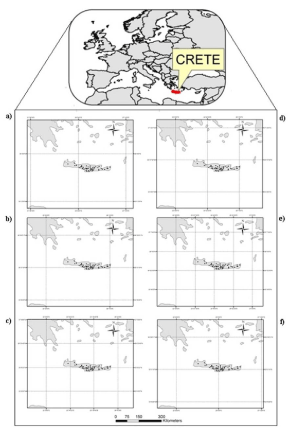 |
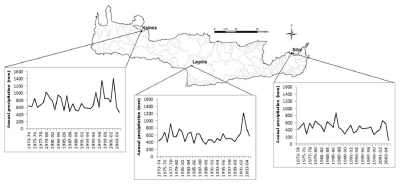 |
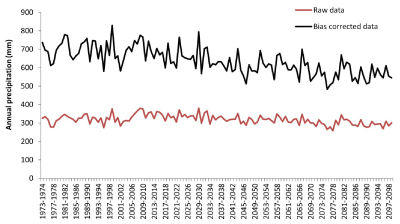 |
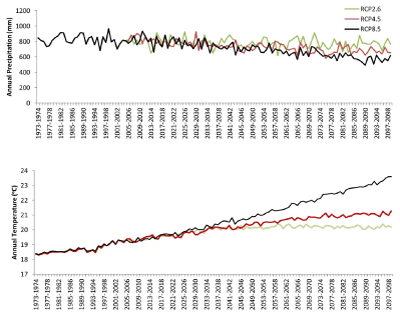 |
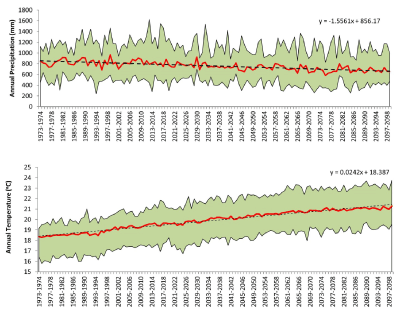 |
| Figure 1 | Figure 2 | Figure 3 | Figure 4 | Figure 5 |
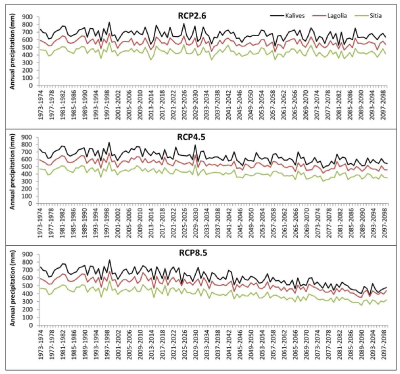 |
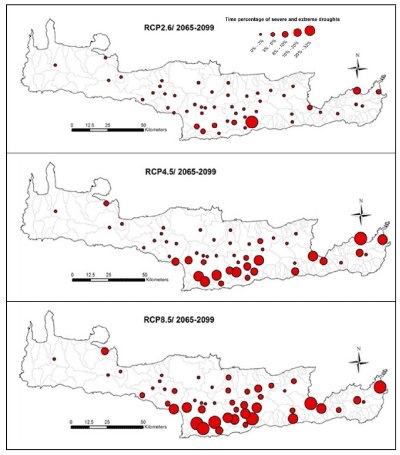 |
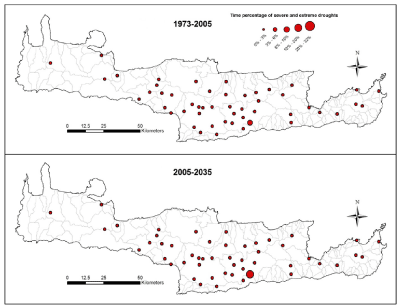 |
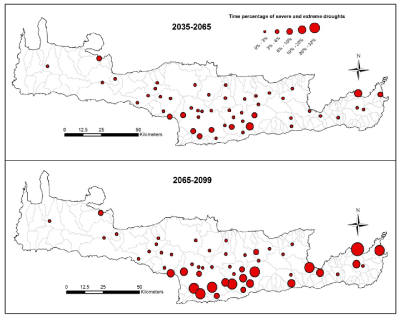 |
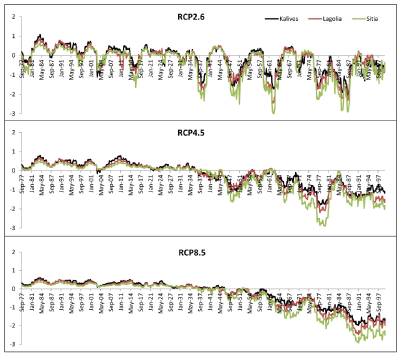 |
| Figure 6 | Figure 7 | Figure 8 | Figure 9 | Figure 10 |
Relevant Topics
- Atmosphere
- Atmospheric Chemistry
- Atmospheric inversions
- Biosphere
- Chemical Oceanography
- Climate Modeling
- Crystallography
- Disaster Science
- Earth Science
- Ecology
- Environmental Degradation
- Gemology
- Geochemistry
- Geochronology
- Geomicrobiology
- Geomorphology
- Geosciences
- Geostatistics
- Glaciology
- Microplastic Pollution
- Mineralogy
- Soil Erosion and Land Degradation
Recommended Journals
Article Tools
Article Usage
- Total views: 14412
- [From(publication date):
December-2013 - Apr 03, 2025] - Breakdown by view type
- HTML page views : 9737
- PDF downloads : 4675
